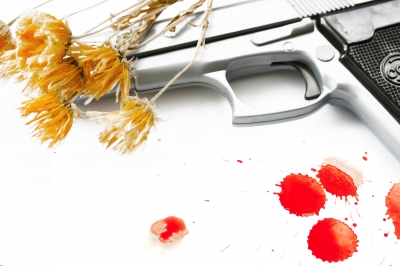Virginia McGhee stepped out to make a phone call while at the funeral of her boyfriend in Baltimore and was shot in the chest. The high murder rate means good business for funeral homes.

Guatemala City and Tijuana have seen an increasing amount of funerary violence and also a bourgeoning and brazen homespun business that feeds off the mayhem. Last month in Baltimore, a woman was murdered at the funeral of her boyfriend, also a murder victim.
Joseph Brown, the owner of the funeral home where McGhee was shot, said he cares for at least two to three homicide victims a month. But after blood was spilled on his own sidewalk, Brown vented to a Baltimore Sun reporter last month that the murderers had gone too far.
Last year, two people were shot outside a West Baltimore church, where 300 mourners had gathered to view the body of a 26-year-old killed in a triple shooting, and in 2001, a man was shot at while leaving the wake of his brother.
“[Respect has] gone out the window,” said Brown. “This has become a fact of life as much here in Baltimore as it is in Afghanistan, Iraq, and anywhere else.”
The more appropriate comparison would be Guatemala City, Guatemala or Tijuana, Mexico. These well-known murder havens, like Baltimore, have seen an increasing amount of funerary violence, and also a bourgeoning and brazen set of homespun businesses that feed off the mayhem.
In Guatemala City, morticians called skullmongers speed to murder scenes looking to snag customers. When rival firms meet on the street, price wars ensue. Some skullmongers offer combos: a coffin, a wake and a funeral for as little as $150. The skullmonger industry is unregulated and growing, reported the Associated Press, last November. Some mongers even receive tips about murders from the police.
A Guatemala City man who goes by the nickname Don Carlos has transformed his mechanic shop into a funeral home, although the initial décor remains. Saw blades and drill bits hang on concrete walls and “in the back, among the old gaskets and engine blocks, the corpses are disemboweled, cleaned, embalmed and dressed for burial,” according to the Associated Press article.
In Mexico, with drug violence spiraling out of control, there is even more money to be made beautifying corpses, but more danger involved too. Funeral home operators from southern and central Mexico head for crime-ridden border towns like Ciudad Juarez and Tijuana, looking to expand their businesses. Some border city funeral homes send agents into the streets to hand out promotional fliers.
“Gun battles and gangland mutilations are also boosting demand for facial reconstructions,” reads a 2008 Reuters article. “And because of the rise in decapitations in the city, undertakers offer to hold the body and wait for the head to be found before proceeding with the funeral.”
The danger of death for Mexican morticians is real, though, and unlike Baltimore, it is often the funeral home owners themselves being targeted. An undertaker from Ciudad Juarez was shot dead in front of his home and numerous mortuaries in the border town, directly opposite El Paso, Texas, have been sprayed with bullets.
Not all morticians from murderous cities are bleeding the victims dry, though. A New York Times article reported the story of Tyrone Muhammad, a mortician, and Kenneth Reece, a coffin-builder. The duo, from Newark, New Jersey, a city that hit an all-time murder high in 2006 with 101 homicides, speeds to murder scenes with a different message: stop the violence.
They call themselves Morticians That Care and they rove the neighborhood in a green company van looking for residents to impress their message upon. The men display body bags, play music and talk about gunshot victims they have stitched up. On one occasion, they showed a video of a young gunshot victim being embalmed.
“I am just sick of patching up bullet wounds,” said Muhammad.
But in the world’s most murderous cities, bullets also mean business.









